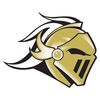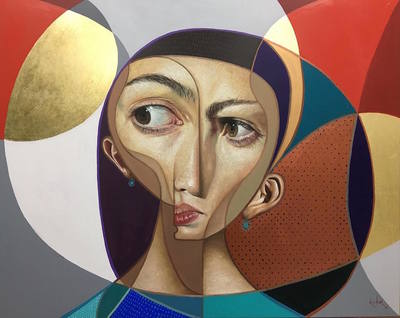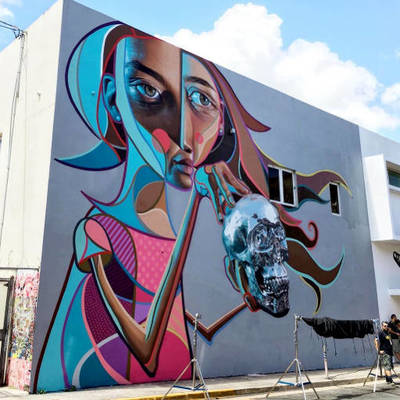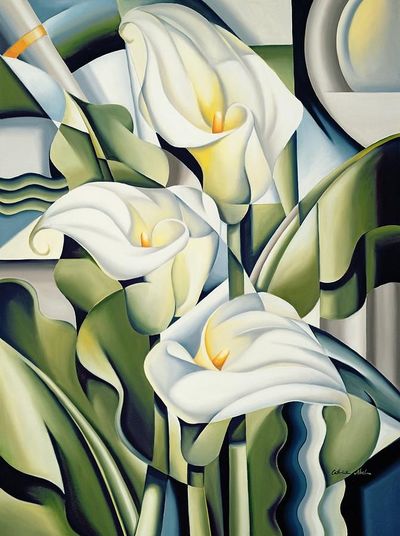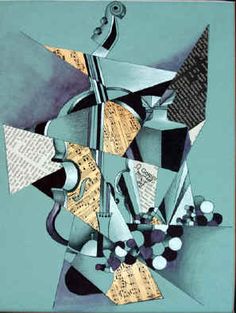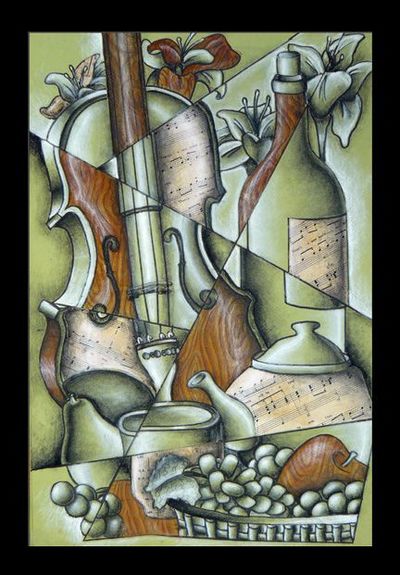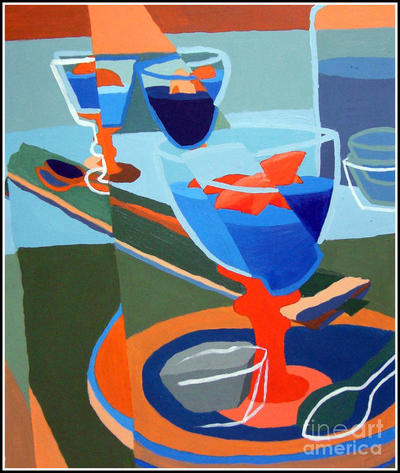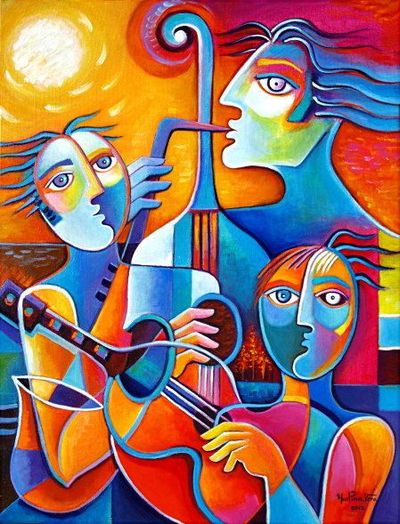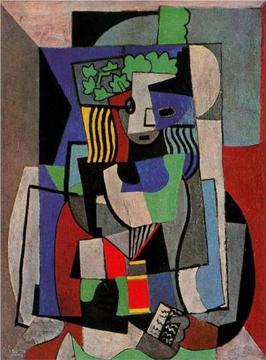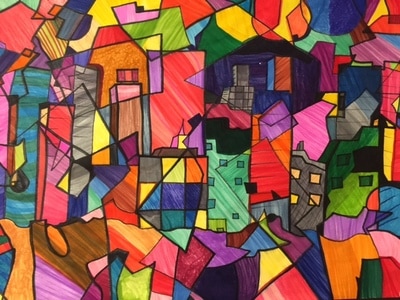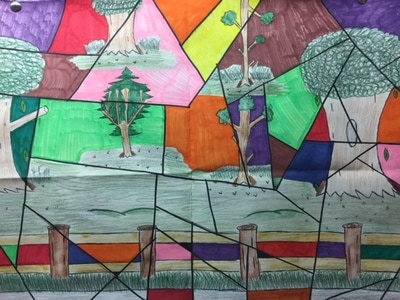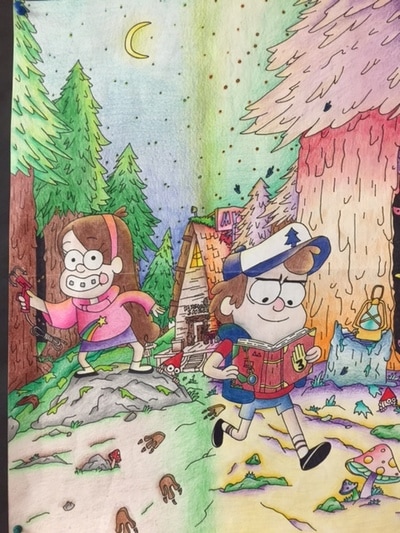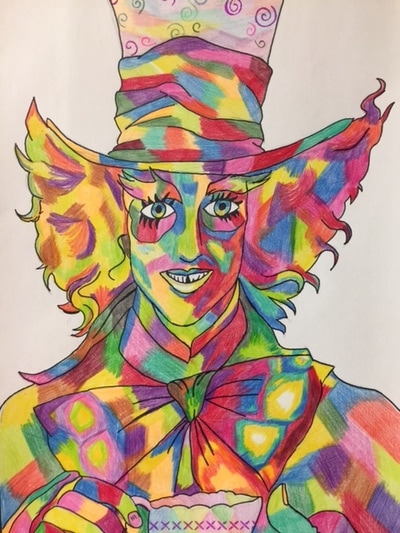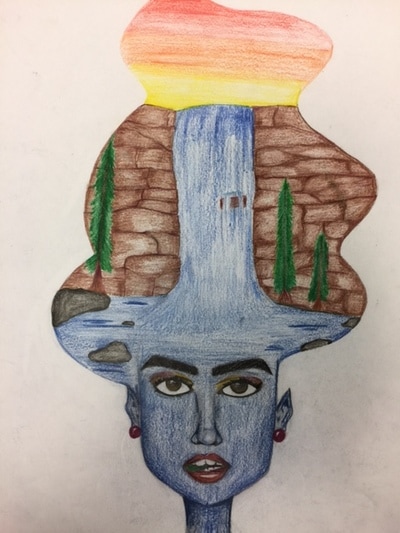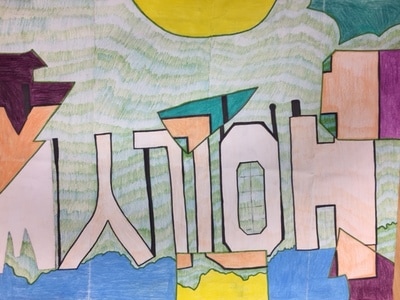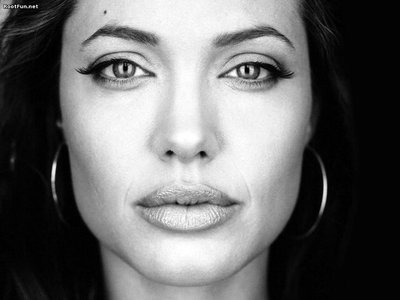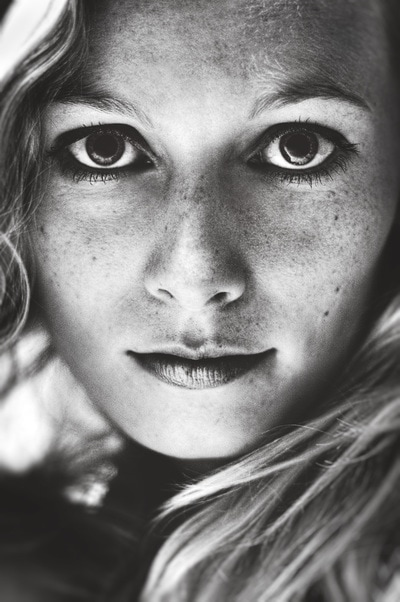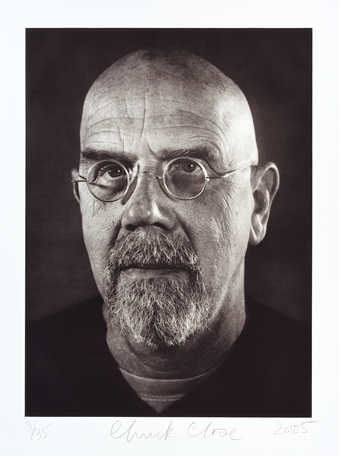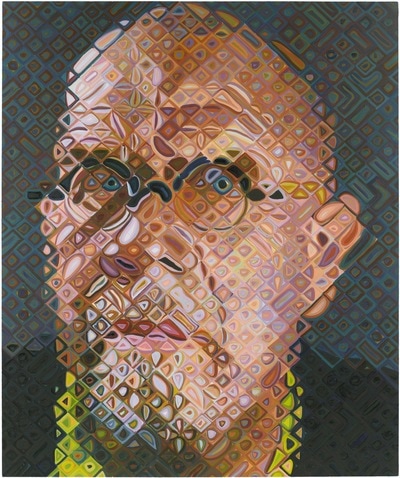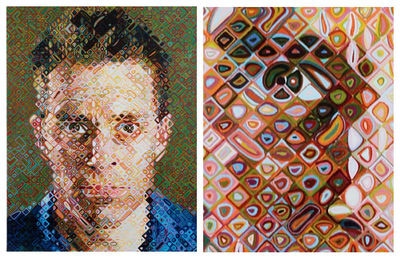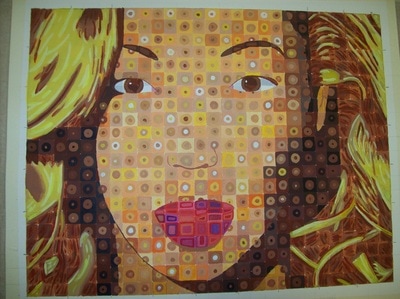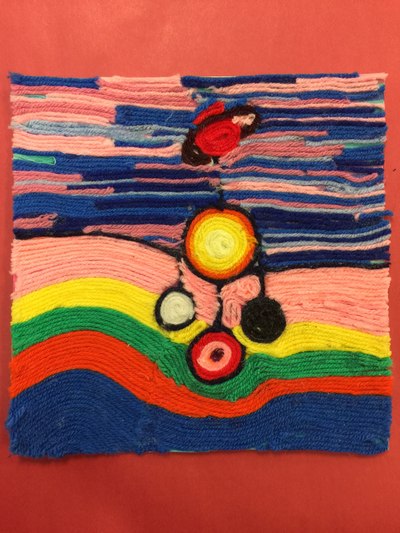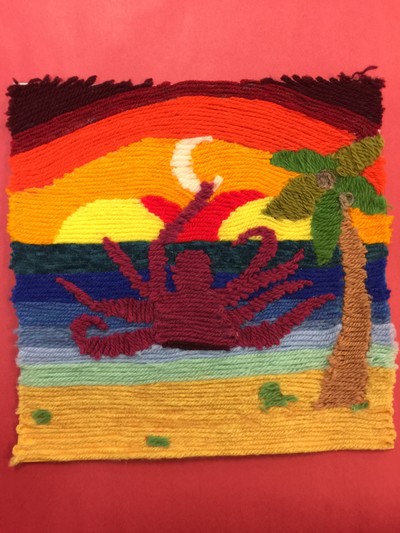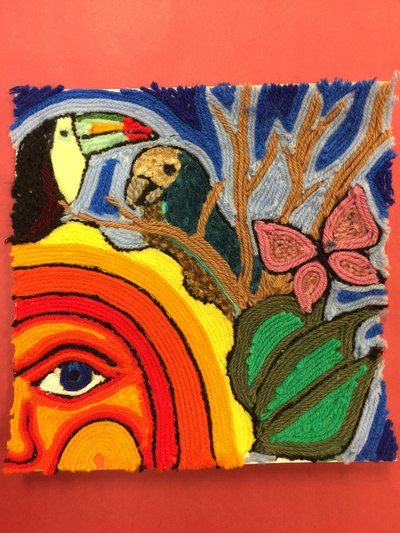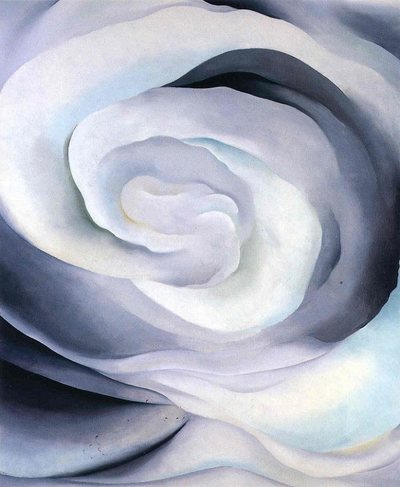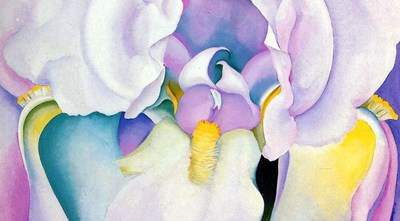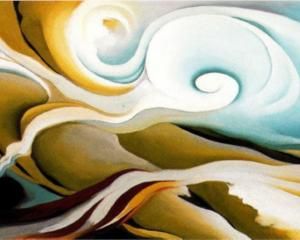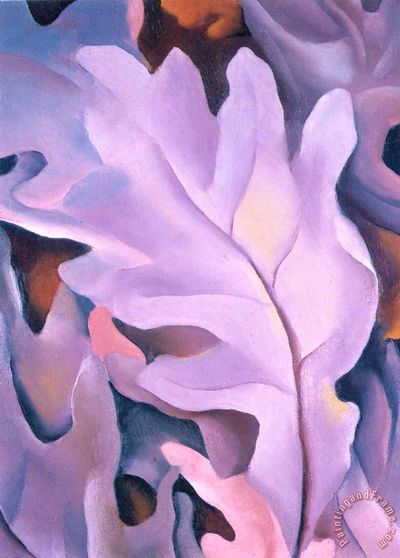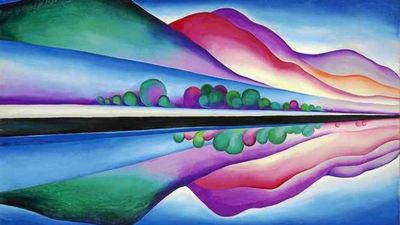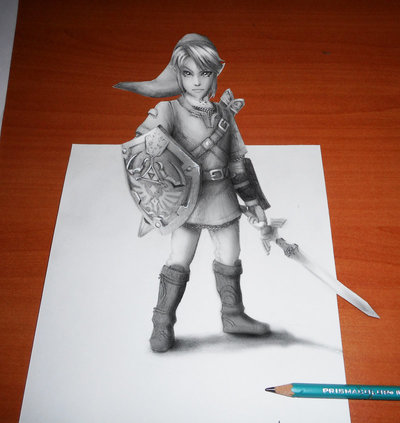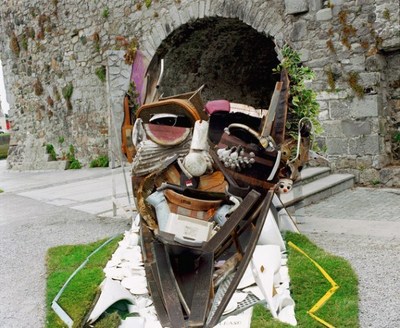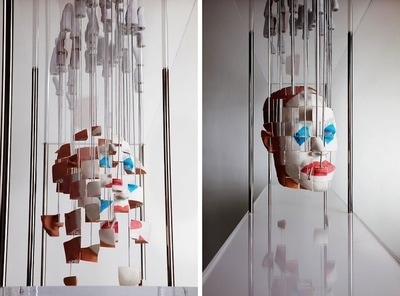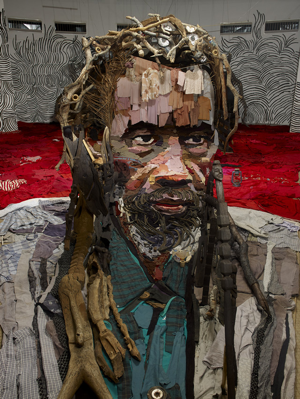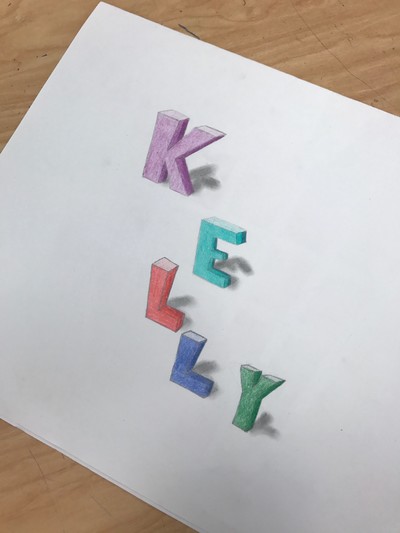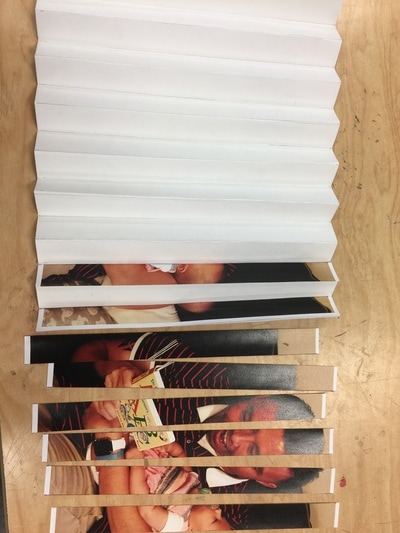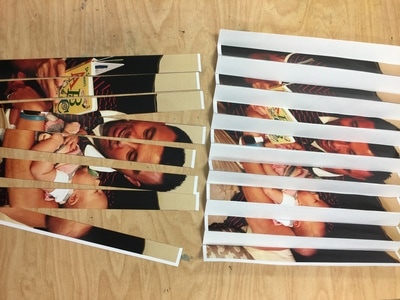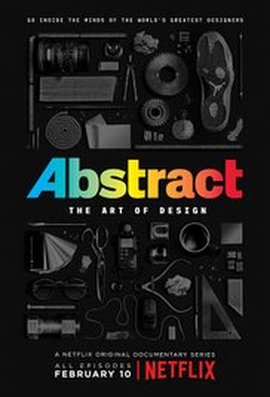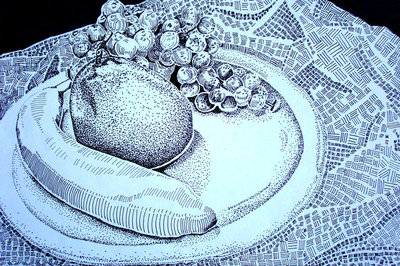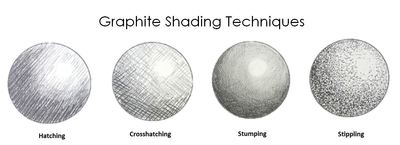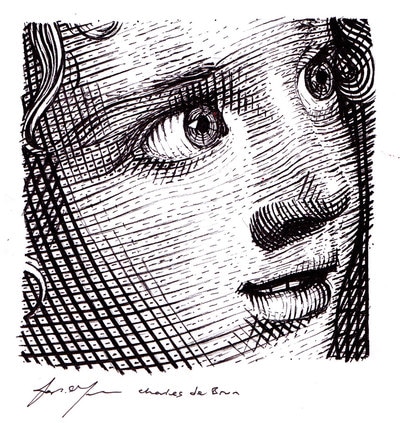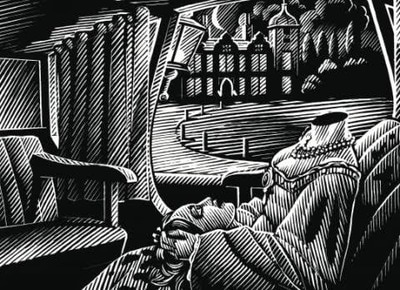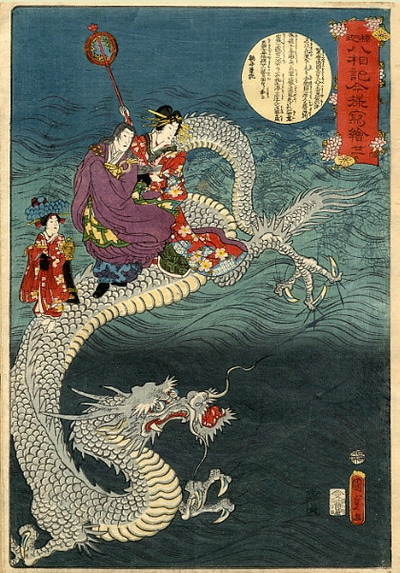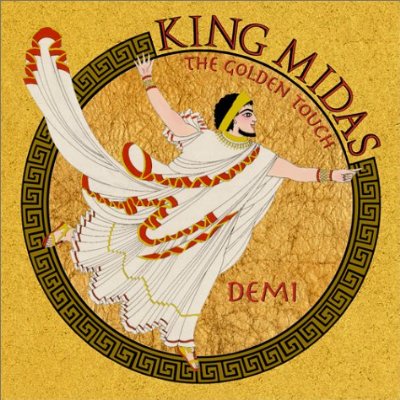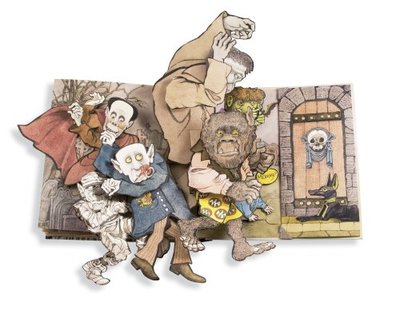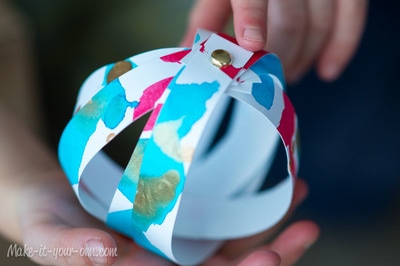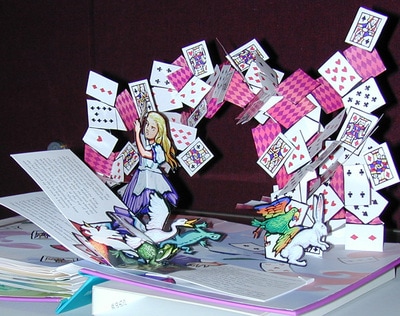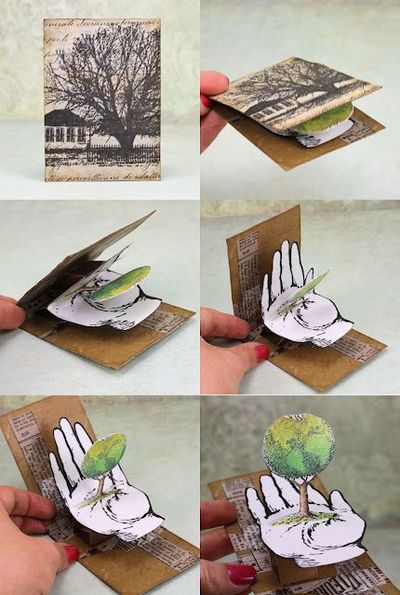| spring_2017_syllabus.docx | |
| File Size: | 12 kb |
| File Type: | docx |
| visual_arts_terminology.docx | |
| File Size: | 27 kb |
| File Type: | docx |
"Every child is an artist. The problem is how to remain an artist once he grows up." -Pablo Picasso
Project 1 - Cubism (Focus: Element of Line and Shape, Principle of Harmony and/or Movement)
- Test 1 - Due Weds Feb 8th
- Objective
- [ Fictional ] Create a composition of a famous place from a movie, show, book, or from real life [Non-Fiction] in Cubist style
- Art terminology
- Shape: is an enclosed space, the boundaries of which are defined by other elements of art (i.e.: lines, colors, values, textures, etc.)
- Movement: In Visual Arts, the direction or flow in artwork.
- Line: The path of a moving point that is made by a tool, instrument, or medium as it moves across an area.
- Harmony: describes the combination of the pictorial elements (color, tone, line, form, content, brushwork, etc..) into a consistent and orderly whole.
- Cubism: an early 20th-century style and movement in art, especially painting, in which perspective with a single viewpoint was abandoned and use was made of simple geometric shapes, interlocking planes, and, later, collage.
- Deconstruction: a philosophical or critical method which asserts that meanings, metaphysical constructs, and hierarchical oppositions (as between key terms in a philosophical or literary work) are always rendered unstable by their dependence on ultimately arbitrary signifiers; also : an instance of the use of this method
- Aesthetics: study of theory of the beautiful, in taste or art
- Materials/Medium: Marker, Color Pencil, Pencil, Crayon - Watercolor optional
- You can select any of them or just 1, carefully select based on need for the best finished product
- Practice on extra paper before Project paper
- Article 1
- Choose:
- http://www.metmuseum.org/toah/hd/cube/hd_cube.htm
- https://www.psychologytoday.com/articles/200907/unlocking-the-mysteries-the-artistic-mind
- Use ONE of the articles and on a separate sheet of paper write:
- 3-2-1: THREE things you learned, TWO questions you still have, ONE aspect of the text you enjoyed or plan to use
- Artist inspiration:
- Pablo Picasso: http://www.picasso.fr/us/picasso_page_index.php
- Belin: http://belin.es/
- Choose:
- Objective
Cubism+Realism Artworks by Miguel Angel Belinchon aka "Belin"
- 1. Critical Thinking
- Sketch your idea
- Examples: Jungle scenes from Avatar, Apocalyptic worlds from books, movies, your house, cityscape of Raleigh
- Use IDEAS you have seen/gathered
- How strong is the overall composition?
- How will you deconstruct the shapes, objects, depth (fore-, middle-, back-ground)?
- Does it fulfill the concept of the Project (cubism)?
- Sketch your idea
- 2. Collaboration
- Have 2 students ADD/SUGGEST ideas to your sketch
- They will use a different colored color-pencil and draw/write images/notes on your sketch
- SUGGESTION: exchange sketches to work efficiently and discuss changes/additions needed
- 3. Create
- Project Rubric
- 10 points: Article
- 10 points: Critical Thinking
- 10 points: Collaboration
- 60 points: Project grade
- 20 points: Use of Cubism elements: deconstruction, multiple perspectives, outlines, shading, patterns
- 20 points: Quality of materials used; gradual shading, lack of loose marks
- 10 points: Representation of a fictional/non-fictional setting
- 10 points: met the project DEADLINE!
- 10 points: Communication & Critique paper
- Each one is an individual grade in the gradebook - just a "Project" will not be enough
- Project Rubric
- 4. (Conclusion of the project) Communicate and Critique
- On a separate sheet of paper write a "Reflection paper" (sentence format and re-state the questions asked) on the following criteria:
- Paragraph one:
- What was the scene you were depicting? Describe the location, setting, objects.
- How did you deconstruct or interchange portions of the picture?
- What changed from your original sketch because of student collaboration or ideas?
- What parts of the picture have shading, bold outlines, or pattern?
- How was LINE, SHAPE, HARMONY, or MOVEMENT used effectively?
- Paragraph two:
- State the student and describe the artwork (colors, setting, materials used)
- Identify the characteristics of the Cubist style (use characteristics of Picasso or Cubism itself)
- Discuss the HARMONY or MOVEMENT in the artwork
- Describe how LINE and SHAPE support the design principles of either Harmony or Movement
- Assess the overall aesthetic quality of the artwork; WHY do you like it, does it remind you of something, etc
- Paragraph one:
- On a separate sheet of paper write a "Reflection paper" (sentence format and re-state the questions asked) on the following criteria:
Examples of Cubism Projects
Finished Work - Student Gallery
Project 2 - Chuck Close Portrait of Interest
- Art Terminology for Project 2
- Color: An element of art defined as the effect of light reflecting from an object onto the eye
- Design: To create a work of art by combining elements of art into a planned whole
- Intensity: Refers to the brightness or dullness of a color; amount of saturation.
- Photography: The art or process of producing images by the action of light on surfaces sensitized by chemical processes.
- Point of View: Refers to the angle at which you view an object.
- Portrait: Artwork that shows the face of a figure of a person.
- Saturation: the degree of chroma or purity of a color; the degree of freedom from admixture with white
- Shade: A dark color achieved by changing the value of a color by adding black.
- Technique: A special way to create artwork, often by following a step-by-step procedure.
- Tint: A light color achieved by changing the value of a color by adding white.
- Chuck Close Article II
- https://www.biography.com/people/chuck-close-9251491
- 3-2-1 protocol
- 3 things you learned – paragraph a piece
- 2 things you liked
- 1 question you have?
- https://www.biography.com/people/chuck-close-9251491
- Style study
- Analyze / identify
- Choice of portrait – person of impact•Why? What? How?
- Choose a person that can answer the questions below? 1 Paragraph per question.
- WHY – did you choose this person
- WHAT– What did they contribute to society? How did they significantly impact society?
- HOW– how do you plan on incorporating evidence in the painting of the chosen person?
- Good source photo - paper size (8x10")
- Balance of black and white
- Front, side, 3/4 profile
- Dynamic or gradual changes in shade
- EXTRA CREDIT: capture an expression
- Choose a person that can answer the questions below? 1 Paragraph per question.
- Collaboration
- Choose a partner to take notes of your photo source; 3 needs
- Have suggestions on color
- Have suggestions on design
- Cite challenges or areas that could prove difficult
- Choose a partner to take notes of your photo source; 3 needs
Source Photo Examples
Chuck Close / Self-Portrait / Dissection of Style
Project 2 Rubric:
-10 points - Article II
-20 points - Why-What-How (3 paragraphs)
-10 points - Evidence of Collaboration
-40 points - Portrait Painting
[10 points - Accuracy to photo]
[10 points - Variation in color]
[10 points - Variation in designs]
[10 points - Met deadline/pacing dates]
-20 points - Communication/Critique
Student Examples
Project 3 - Tattoo Project
“Our bodies were printed as blank pages to be filled with the ink of our hearts” - Michael Biondi
Click -> Read ALL the links below.
Click -> Read ALL the links below.
Article 3
Before CRITICAL THINKING and sketching - Use the 2 articles above to answer the following questions;
Before CRITICAL THINKING and sketching - Use the 2 articles above to answer the following questions;
- There are 8 styles described in the article; List them all and briefly describe them in your own words to diagnose and analyze the characteristics of each style.
- What is the difference between "New School" and "Traditional" tattoos?
- What is the difference between "Traditional" and "Neo-Traditional"?
- How far back does the art of Tattooing go?
- Why were tattoos used as labels in Borneo?
- How did the expansion of Egypt's empire spread Tattooing and how did each culture use it differently?
- What did British sailors William Dampher and Captain Cook similarly both bring back to London?
- What breakthrough happened in 1891 thanks to Samuel O'Rtiely?
- Where is the birthplace of tattooing in America?
- What caused drawbacks and loss of appeal of tattooing in American culture in the 1920s and 1960s?
Watch the short docu-series "The Art of Ink" (video below) on Spike courtesy of Youtube. It also introduces the styles Trash Polka and Biomechanical.
Project 4 Huichol Yarn Painting
Project 5 Georgia O'Keeffe Pastel Project
Article Five Questions:
- Who gave her first show and what year was it?
- O'Keeffe was coined as the mother of what art movement?
- Where did O'Keeffe's early curiosity in Art stem from?
- How did Ida Totto help her interest in Art?
- At the Art Institute of Chicago, who did O'Keeffe study under?
- When O'Keeffe left for NY, name the three artists she worked with and what artwork did she receive a prize for?
- Alon Bement would help O'Keeffe in what way?
- In 1915, O'Keeffe was credited with being on the first artists to practice with what style?
- Because of the vibrancy of the modern art movement, O'Keeffe began to experiment with what technique?
- RESEARCH - reading through the article, it references several of her most famous pieces; do an IMAGE WEB SEARCH (of use the images below) and name 2 of them and how you can use the style and technique in your project.
Project 6
Views from the 919 - David Hockney Photography Project
Project 7 - Watercolor and Prismacolor Sign Language
Project 8:
Anamorphic Art and Perspective
Critical Thinking:
Using the foundations of Perspective, how can students create unique anamorphic illusions?
How can the process of constant problem-solving and failure become part of the final product?
Collaboration:
Students will view 2 links:
Using the foundations of Perspective, how can students create unique anamorphic illusions?
How can the process of constant problem-solving and failure become part of the final product?
Collaboration:
Students will view 2 links:
Students will do a 3-2-1 protocol:
Students will create a choice of either - an anamorphic artwork using perspective OR a small scale installation piece that can be seen from 1 angle
10 points - Critical Thinking sketches
10 points - Collaboration Input from students
10 points - Communication Question
60 points - Project
Click on the images below of Drawing and Sculpture examples!
- 3 Ideas + sketches to present to another student - Attach to your CRITICAL THINKING pages
- 2 Suggestions they received from another student (NOT COMPLIMENTS! Enhance/Help the idea!) - record in the COLLABORATION section of handout
- 1 Question they have about the process/project - record in the COMMUNICATION section of handout
Students will create a choice of either - an anamorphic artwork using perspective OR a small scale installation piece that can be seen from 1 angle
- Students should think about backwards thinking - IDEAL final result
- Trial/error process - KEEP all failed sketches or catalog failed experimental methods
- The importance of perspective to aid/guide their idea
- OPEN media - Students will use materials based on the subject matter best suited for finished results
- For installations, students can use a wide range of objects or miniature pieces of their artwork (worked on pieces, not necessarily finished works)
- For Anamorphs, students can use marker, color pencil, watercolor, and/or combinations to reach full requirements of an illusion.
10 points - Critical Thinking sketches
10 points - Collaboration Input from students
10 points - Communication Question
60 points - Project
- 15 points - Use of Perspective
- 15 points - Use of shading to enhance illusion (color or chiaroscuro [no color])
- 15 points - Level of difficulty and creative thinking / problem solving (physical evidence)
- 15 points - Craftsmanship / presentation of finished piece or installation
- Video posted to personal website to Critique Questions
- Photos of project process
Click on the images below of Drawing and Sculpture examples!
Student Examples
Project 9 "Agamographs"
Theme: Evolution of Time/Culture
Students objective/challenge:
Students must capture the change in time that affects the non-fictional subject matter.
What lead to the change?
How did it affect you personally?
What elements of the picture did you focus on to manipulate the change (background, focal points, objects, etc..)?
WHAT IS AN AGAMOGRAPH?
An agamograph is a series of images that change at different angles. This work is named after the Israeli sculptor, Yaacov Agam who was born in 1928 and still living today (2017). This artist is known for his optical and kinetic art. To create his agamographs he used “lenticular printing."
Students must capture the change in time that affects the non-fictional subject matter.
What lead to the change?
How did it affect you personally?
What elements of the picture did you focus on to manipulate the change (background, focal points, objects, etc..)?
WHAT IS AN AGAMOGRAPH?
An agamograph is a series of images that change at different angles. This work is named after the Israeli sculptor, Yaacov Agam who was born in 1928 and still living today (2017). This artist is known for his optical and kinetic art. To create his agamographs he used “lenticular printing."
Article II:
On the article button above, answer the following questions after reading the link/article:
What is your subject? Is the physical change on a setting due to an event? Is it the depiction of how culture affects a person?
What will be the medium? Keep in mind that these projects will be cut for the affect - pastels and blending mediums tend to smear when handled.
Collaboration:
Fold your Critical Thinking paper sketch in half or draw a line through the middle so the collaborator can evaluate both pieces/sketches.
Collaborator will use LINES and NOTES to add or critique changes on the bottom portion of your sketch paper. ENHANCE the sketch not deduce it.
On the article button above, answer the following questions after reading the link/article:
- Which picture was your favorite photograph? Write the title and date.
- Why was it your favorite and how did Stephen Wilkes accomplish the change in time in that scene?
- Why were people so inspired by Stephen's photography?
- What grant did he receive recently?
- What can you use [from these photos and article] to help you create time transitions for your project?
What is your subject? Is the physical change on a setting due to an event? Is it the depiction of how culture affects a person?
What will be the medium? Keep in mind that these projects will be cut for the affect - pastels and blending mediums tend to smear when handled.
Collaboration:
Fold your Critical Thinking paper sketch in half or draw a line through the middle so the collaborator can evaluate both pieces/sketches.
Collaborator will use LINES and NOTES to add or critique changes on the bottom portion of your sketch paper. ENHANCE the sketch not deduce it.
Create:
10 points - Article II - Due Monday, May 1st
10 points - Critical Thinking sketch - Due Tuesday, May 2nd
10 points - Collaboration input - Due Wednesday, May 3rd
60 points - Agamograph
- Students will receive 2 sheets of 8x10" project papers
- Draw the 2 (non-fiction) images that you want to transform over TIME. Students also have voice/choice to their medium/materials to finish the drawings with.
- Draw 1" marks at the top/bottom of the drawings to create vertical lines. Use scissors to cut your drawings into 1" strips. WARNING: don't lose the order of your strips so that they can be easily glued.
- Take your 16x10" project paper and draw 1" marks at the top/bottom so you can draw even vertical lines.
- On each line, fold them in a fan-like pattern (note the images above).
- Finally, make sure your pieces are organized and glue them to the correct corresponding sides (one image should only be glued on the left side of the folded paper and the other image on the right side of the folded paper)
10 points - Article II - Due Monday, May 1st
10 points - Critical Thinking sketch - Due Tuesday, May 2nd
10 points - Collaboration input - Due Wednesday, May 3rd
60 points - Agamograph
- 10 points - Uses continuity between both drawings
- 15 points - Easy reference to non-fictional subject matter
- 15 points - A change in time occurs
- 10 points - Meets project deadline - Monday, May 8th
- 10 points - Proper medium chosen to complete project
- Students will record a quick video that captures the gradual change of their kinetic work
- Students will use teacher-written questions to evaluate their Agamographs on the backs of their Critical Thinking worksheets on the page titled; Communication/Critique.
Abstract: The Art of Design
Project 10: Scratching on Goldfoil
Texture in Line and Cultural Folklore
Student Objective(s):
Can the student execute different shading techniques on an unforgivable surface or adapt to mistakes?
What different folklore(s) can the student's learn, depict, or research about?
What visual patterns are derived from specific cultures?
How can you use the Design Principle of Unity to bring together a story or elements of a picture?
Folklore is the traditional, unofficial, non-institutional part of culture. It encompasses all knowledge, understandings, values, attitudes, assumptions, feelings, and beliefs transmitted in traditional forms by word of mouth or by customary examples.
Critical Thinking
Students will research 2 different cultural folklore and decide how they want to sketch the whole story or scene in that story. They must also tie in either a patterned border or tie in the pattern into the picture that relates to the chosen culture.
Collaboration
Students will compare stories/scenes and describe what cultures they come from
Partners will decide on the UNITY aspect and how to compose elements of the story to strengthen to visual evidence
Create
Students can use tracing paper or simply re-draw their "critical thinking" sketch onto their 8.5x11" scratch-board project paper.
Students must use a sharp object but try different points for given effects.
Cross-hatching, hatching, stippling, contour lines are different shading effects that would be EFFECTIVE on this given project.
Can the student execute different shading techniques on an unforgivable surface or adapt to mistakes?
What different folklore(s) can the student's learn, depict, or research about?
What visual patterns are derived from specific cultures?
How can you use the Design Principle of Unity to bring together a story or elements of a picture?
Folklore is the traditional, unofficial, non-institutional part of culture. It encompasses all knowledge, understandings, values, attitudes, assumptions, feelings, and beliefs transmitted in traditional forms by word of mouth or by customary examples.
Critical Thinking
Students will research 2 different cultural folklore and decide how they want to sketch the whole story or scene in that story. They must also tie in either a patterned border or tie in the pattern into the picture that relates to the chosen culture.
Collaboration
Students will compare stories/scenes and describe what cultures they come from
Partners will decide on the UNITY aspect and how to compose elements of the story to strengthen to visual evidence
Create
Students can use tracing paper or simply re-draw their "critical thinking" sketch onto their 8.5x11" scratch-board project paper.
Students must use a sharp object but try different points for given effects.
Cross-hatching, hatching, stippling, contour lines are different shading effects that would be EFFECTIVE on this given project.
Examine the STYLE and Cultural Connection in these Styles below:
Project 11:
Art with Movement about a Movement
The student will create a work of art that can shift, move, or simply be physically interactive - but have an impactful meaning on societal issues.
Student Will:
-Challenge their abilities on the foundations of this class; critical/creative thinking, experimental-failure-success process, and speak visually.
-Understand that this will be your FINAL project - focus on the message and how that message can be conveyed outside a flat surface.
-Find solutions for a potentially bending, twisting, spinning, mobile piece of artwork.
Click on the link below and see how students from NTUA created a tasty (yet dangerous) way to spread awareness for their artwork.
Student Will:
-Challenge their abilities on the foundations of this class; critical/creative thinking, experimental-failure-success process, and speak visually.
-Understand that this will be your FINAL project - focus on the message and how that message can be conveyed outside a flat surface.
-Find solutions for a potentially bending, twisting, spinning, mobile piece of artwork.
Click on the link below and see how students from NTUA created a tasty (yet dangerous) way to spread awareness for their artwork.
5 questions about Article III:
1. What was the title of their project? Describe what it consisted of.
2. Why popsicles? How did one member from the design team explain why they made the delicacy as the subject matter?
3. Name some of the gruesome things that were preserved in the final results.
4. What do they hope is the biggest takeaway from this project?
5. Despite this being an artwork without movement, it had the power to send a moving message - what can be applied to your project that was inspired by this article or from Interpretations 1-5 (under the top main menu - under "more" or "Art Interpretations") assignment.
1. What was the title of their project? Describe what it consisted of.
2. Why popsicles? How did one member from the design team explain why they made the delicacy as the subject matter?
3. Name some of the gruesome things that were preserved in the final results.
4. What do they hope is the biggest takeaway from this project?
5. Despite this being an artwork without movement, it had the power to send a moving message - what can be applied to your project that was inspired by this article or from Interpretations 1-5 (under the top main menu - under "more" or "Art Interpretations") assignment.
Critical Thinking
For your sketch/blueprint, what is your TOPIC first?
How would you want to VISUALLY express that topic?
In the visual, can the scene have movable parts OR can the scene be entirely moved?
*Pop-up scenes, origami, using brass fasteners, folding parts, segmented parts of the picture move only, etc..
Collaboration
THIS TAKES 2-3 ARTISITIC minds (aka Problem-Solvers) - help one another. Answer these 3 questions about their sketch.
1. What is your opinion of their relationship of sketch and social issue? What is lacking?
2. Does the moving part(s)/idea seem challenging enough? How can you help?
3. What mediums would you use to maximize or best suit the project?
Rubric
10 points - Art Interpretations 1-5 (paragraph for each)
10 points - Article III's 5 questions
10 points - Critical Thinking blueprint
10 points - Collaboration Notes
Project
15 points - Artwork has ability to be physically moved
15 points - Artist used visual evidence to speak about social issues
15 points - Creativity & execution of finished product
15 points - Mixed mediums (more than 1) enhance project results
For your sketch/blueprint, what is your TOPIC first?
How would you want to VISUALLY express that topic?
In the visual, can the scene have movable parts OR can the scene be entirely moved?
*Pop-up scenes, origami, using brass fasteners, folding parts, segmented parts of the picture move only, etc..
Collaboration
THIS TAKES 2-3 ARTISITIC minds (aka Problem-Solvers) - help one another. Answer these 3 questions about their sketch.
1. What is your opinion of their relationship of sketch and social issue? What is lacking?
2. Does the moving part(s)/idea seem challenging enough? How can you help?
3. What mediums would you use to maximize or best suit the project?
Rubric
10 points - Art Interpretations 1-5 (paragraph for each)
10 points - Article III's 5 questions
10 points - Critical Thinking blueprint
10 points - Collaboration Notes
Project
15 points - Artwork has ability to be physically moved
15 points - Artist used visual evidence to speak about social issues
15 points - Creativity & execution of finished product
15 points - Mixed mediums (more than 1) enhance project results
